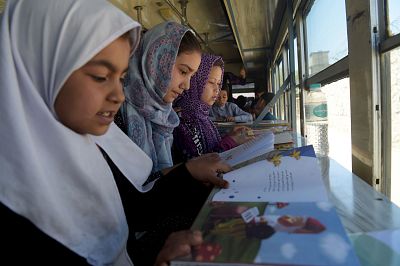Conflict, poverty, child marriage and discrimination against girls are reportedly the main reasons they miss out on educations.
Nearly half of all Afghan children are missing out on school due to conflict, poverty, child marriage and discrimination against girls, according to a report released Saturday by humanitarian organizations.
As many as 3.7 million children between the ages of 7 and 17 are not attending class, according to the report conducted by USAID, UNICEF and independent think-tank Samuel Hall.
Girls are disproportionately affected, accounting for 60 percent of those denied access to education. In the worst affected provinces, up to 85 percent of girls do not attend class.
The report marks the first time the out-of-school rate in Afghanistan has increased since 2002. In addition, a further 300,000 children who currently attend school are at risk of dropping out.
The study is part of the "Global Initiative on Out of School Children," which falls under the2030 Sustainable Development Goals. The fourth goal aims to "ensure inclusive and equitable quality education and promote life-long learning opportunities for all."
Afghanistan's Constitution calls for the free provision of education by the state until the level of bachelor's degree, but millions of children nonetheless miss out on schooling.
The Taliban, seeking to oust the U.S.-backed government and return the country to strict Islamic rule after their 2001 ouster, are adamantly opposed to education for girls. Threats from ISIS have also forced the closure of dozens of schools.
Schools have also been the targets of attacks. In April, militants set fire to two schools and widespread violence led to the closure of hundreds of private schools.
The report finds that cultural beliefs and practices negatively impact girls' chances of attending school in Afghanistan. It found that in certain areas girls are not not allowed to attend school, or are only permitted to attend religious institutions.
Insecurity on the journey to and from school is another reason frequently given for why girls should not attend class, but is less frequently given for why boys should stay at home.
Child marriage remains the second most reported reason for girls dropping out of school, at 19 percent. While only 3 percent of boys discontinued their education because of marriage.
The most frequently given reason for girls dropping out of school was "because their parents did not send them to school."
"Business as usual is not an option for Afghanistan if we are to fulfill the right to education for every child," said Adele Khodr of UNICEF in the report. "When children are not in school, they are at increased danger of abuse, exploitation and recruitment."
Acting Minister for Education Mohammad Ibrahim Shinwari, who wrote the foreword to the report, said his country was committed to goal four of the Sustainable Development Goals and believed education was "one of the most powerful and proven vehicles for progress."
"We cannot achieve our government's ambitious plan for long-term prosperity in Afghanistan without continuing to prioritize programming that brings out-of-school children into the education system," he wrote.












